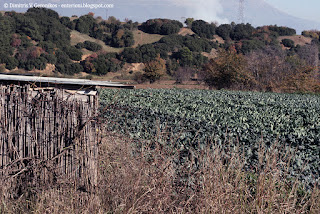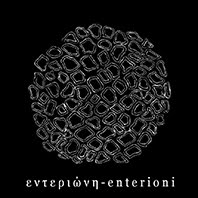Κατά
τη διάρκεια του περασμένου καλοκαιριού
η Έρκου και ο Νταβίντ με προσκάλεσαν σ’
ένα ταξίδι στην κωμόπολη Μαϊμόνα (: Los
Santos de Maimona) της δυτικής Ισπανίας, ώστε
να συμμετέχουμε στην 8η διεθνή συνάντηση
του δικτύου Arquitecturas Colectivas (AA.CC.). Η Μαϊμόνα βρίσκεται στα σύνορα με
την Πορτογαλία, στην περιφέρεια της
Εξτρεμαδούρα, με σύμβολο για την τοπική
κοινωνία να είναι ο
χοίρος και τα μεγάλα βοσκοτόπια.
To δίκτυο AA.CC. (σε ελέυθερη μετάφραση Συλλογικές Αρχιτεκτονικές) αποτελείται από άτομα και ομάδες που ενδιαφέρονται για τη συμμετοχική δημιουργία του αστικού περιβάλλοντος. Η πρόθεσή του είναι να συνδέσει τους διάφορους φορείς αστικής επιρροής προς την κατεύθυνση της συλλογικής δημιουργίας των ανθρωπογενών ενδιαιτημάτων. Ενδιαίτημα είναι ο οικότοπος (: habitat) που χαρακτηρίζεται από συγκεκριμένες συνθήκες, εκεί ζει και αναπαράγεται συνήθως ένα είδος, ένας πληθυσμός ή μία βιοκοινότητα. Αποτελεί μια σύνθετη οντότητα, που στα σύγχρονα αστικά σύνολα συνδυάζει την κατασκευή και την κοινωνία, τις πολιτισμικές και τεχνολογικές πτυχές του δικτύου.
Ουσιαστικά, το προαναφερόμενο δίκτυο παρέχει ένα οργανικό πλαίσιο για κατανεμημένη συνεργασία σε διάφορους τύπους έργων και πρωτοβουλιών. Αυτό εκδηλώνεται κυρίως με τρεις τρόπους:
-
με φυσικές συναντήσεις προσώπων (όπου
γίνεται ανταλλαγή εμπειριών, εργαστήρια,
δοκιμή πρωτοτύπων),
-
με συστήματα διαδικτυακής κι όχι μόνο
επικοινωνίας (on-line) και
-
με συνεργατικά έργα-διαδικασίες (μελέτη
και κατασκευή έργων, συνεργασία και
υποστήριξη συμμετοχική διαδικασιών,
πόροι, ανταλλαγή εμπειριών και αμοιβαίας
υποστήριξης).
Η
διεθνής συνάντηση λοιπόν, από 4 έως 13
Σεπτεμβρίου, αφορούσε στη συμμετοχική
αναδιοργάνωση του αστικού χώρου ∙
σ' αυτήν συμμετείχαν περισσότερες από 30
συλλογικότητες και 200 περίπου άτομα
προερχόμενα από το σύνολο της ισπανικής
επικράτειας, τη Λατινική Αμερική, και
την Ευρώπη, με συνδετικό κρίκο τις
διαφορετικές πρακτικές, οι οποίες
σχετίζονται με τα κοινά.
Το
σύνθημα του συνεδρίου ήταν #PorkInProgress.
Ένα παιχνίδι με λέξεις και με πολλαπλές
αναγνώσεις, που καθορίζονται από τη
χρήση ενός από τα πιο αντιπροσωπευτικά
σύμβολα του συλλογικού φαντασιακού για
την περιφέρεια της Εξτρεμαδούρα, όπως
είναι το χοιρινό. Ένα παιχνίδι ανάμεσα
στην έννοια της "εργασίας σε εξέλιξη",
η οποία αντιπροσωπεύει το δίκτυο AA.CC.,
βασισμένη σε μία ζωντανή διαδικασία
αλλαγής, διαπερατής και οργανικής
ανάπτυξης.
Η συνάντηση είχε ως έδρα τις εγκαταστάσεις La Fábrika detodalavida (LFdTV), ένα χώρο που αυτοπροσδιορίζεται ως «κοινωνικό εργοστάσιο για τη διαχείριση της γης, του ελεύθερου χρόνου και κουλτούρας της υπαίθρου, όπου πρακτικές συνεργασίας δημιουργούνται γύρω από τις φιλοσοφίες του ελεύθερου πολιτισμού και των κοινών».
Οι προαναφερόμενες εγκαταστάσεις ήταν ένα εγκαταλελειμμένο από το 1974, εργοστάσιο παραγωγής τσιμέντου που εκτείνεται σε 40.000 τετραγωνικά μέτρα δημόσιας γης.
Μία
βασική εργασία είναι
η δημιουργία ταξινομημένων δομών
προκειμένου να διευκολύνονται αλλαγές, που προωθούν
την ανθρώπινη διαχείριση του πολιτισμού
ως ανοιχτό κώδικα, την αυτοδιαχείριση
ως πολιτική πράξη και ικανότητα προσαρμογής στις τοπικές συνθήκες και ανάγκες της κάθε περιοχής, αφήνοντας
εκτός οντότες
που δεν συμφωνούν με τις αρχές αυτές. Η
συνάντηση αυτή έχει επίσης ως στόχο να
πραγματοποιήσει μια διευρυμένη απεικόνιση
των αναγκών, επιθυμιών και προτεραιοτήτων
των πολιτών, ώστε να μάθουν από τις
βέλτιστες πρακτικές και στρατηγικές
που διασφαλίζουν στην κοινωνία μια
συμμετοχική πόλη.
Η συμμετοχή μας εκεί, συνδυάστηκε με την παρουσίαση εργαλείων για το δημόσιο χώρο, όπως είναι το Public Space Tools (PST) ένα εργαλείο που αναπτύχθηκε από Straddle3 (Βαρκελώνη) και WWB (Σεβίλλη) για την προώθηση της χειραφέτησης των πολιτών σε κρίσιμες, δημιουργικές και αντισυμβατικές εφαρμογές. Παράλληλα παρουσιάστηκε κι εξηγήθηκε ο τρόπος με τον οποίο λειτουργεί το εργαλείο arquitecturascolectivas.net.
Κατά τη διάρκεια του εργαστηρίου παρουσιάστηκαν κατευθυντήριες οδηγίες για την ενεργοποίηση του προαναφερόμενου χώρου, ενός νέου πόρου ανοικτού δικτύου, που αποτελεί το αποτέλεσμα πολλών ετών συλλογικής εργασίας, έρευνας από ομάδες και άτομα που εμπλέκονται στην ανάπτυξη νέων εργαλείων για τη συμμετοχική αναδημιουργία του αστικού περιβάλλοντος και συνδέονται με την κοινότητα AA.CC..
Προσωπικά, κλήθηκα να παρουσιάσω τι συμβαίνει στην Ελλάδα τα τελευταία χρόνια με τη χρήση του δημόσιου χώρου από τους πολίτες (από τα χρόνια των έργων των ολυμπιακών αγώνων 2004 και μετά), ιδιαίτερα των πάρκων και των χώρων πρασίνου υψηλής βλάστησης - επικεντρώνοντας στη διάσταση για αυτοδιαχείριση των χώρων αυτών. Παράλληλα πραγματοποίησα ένα φωτογραφικό ρεπορτάζ του συνεδρίου.
Η συζήτηση μετά τις παρουσιάσεις ανέδειξε το κοινό ενδιαφέρον για την επικαιροποίηση της έννοιας Αγορά στη σύγχρονη εποχή, όπως αυτή νοηματοδοτήθηκε στα κλασσικά χρόνια, σημαίνοντας δηλαδή την καρδιά της δημόσιας ζωής της πόλης.
Ήταν ένα συνέδριο με ελεύθερο και ανοικτό χαρακτήρα που στόχευε κυρίως στο να συνομιλήσουν οι συμμετέχοντες, να ανταλλάξουν ιδέες και να εργαστούν για τη συμμετοχική και συλλογική αναδιαμόρφωση του αστικού περιβάλλοντος σε όλες τις πτυχές του, από την κοινωνιολογία και την ανθρωπολογία, τον ακτιβισμό και την εκπαίδευση, την κοινωνική και πολιτισμική διαχείριση, την αρχιτεκτονική τοπίου και την οικολογία, την πολεοδομία και την τεχνολογία έως τους αμέτρητους επαγγελματίες που εργάζονται εντός του δικτύου της κοινότητας.
Παράλληλα άλλες προσδοκίες των διοργανωτών που επετεύχθησαν σε μεγάλο βαθμό, αποτέλεσαν:
-
Η ανάδειξη της πόλης φιλοξενίας Los Santos
de Maimona, των γραφικών της γωνιών, του
λαϊκού πολιτισμού και τοπικής γαστρονομίας
και κατ’ επέκταση ολόκληρης της
περιφέρειας της Εξτρεμαδούρα.
-
Η στήριξη της πρωτοβουλίας La Fábrika
detodalavida και των δομών εργασίας της, ως
σημείο αναφοράς για την εξυγίανση των
δημόσιας φυσικής κληρονομιάς των χώρων
εν αχρηστία.
-
Η εξερεύνηση και η ενίσχυση ορισμένων
από τις συνεργατικές πρακτικές που
λαμβάνουν χώρα στην περιοχή, η δικτύωση
και διασύνδεσή τους σε διεθνές επίπεδο
με άλλα παρόμοια έργα.
Η φετινή συνάντηση έχει ιδιαίτερη αξία διότι σμίλεψε με ενδιαφέροντες τρόπους την ενίσχυση της ταυτότητας των ανθρώπων στο αγροτικό περιβάλλον, μέσω συλλογικών και δημιουργικών δράσεων. Mε λίγα λόγια, πως οι πολίτες μπορούν να εμπλακούν άμεσα σε αυτό-οργανωμένες διαδικασίες που συμβάλουν στη διακυβέρνηση των πόλεων. Έργα και πράξεις όπου οι άνθρωποι συν-εργάζονται μέσω κοινών δραστηριοτήτων με τις οποίες διαμορφώνουν το περιβάλλον τους, βελτιώνουν τη ζωή τους και αναπτύσσουν νέες κοινωνικές και οικονομικές σχέσεις.
Το επόμενο ραντεβού για το 2016, αποφασίστηκε συλλογικά στη συνέλευση του συνεδρίου, να πραγματοποιηθεί στην αγαπημένη πόλη της Μαδρίτης.
Μπορείτε να δείτε περισσότερες φωτογραφίες στους συνδέσμους που ακολουθούν:
Λήψη φωτογραφιών από © Δημήτρη Β. Γερονίκο στο οικοσύστημα ¨LaFábrika detodalavida (LFdTV)¨ στη γεωγραφική περιοχή που ονομάζεται Los Santos de Maimona (Extremadura), κατά τη διάρκεια της περιόδου μεταξύ των ημερών 9 και 13 Σεπτεμβρίου δύο χιλιάδες δεκαπέντε.
Photos by © Dimitris V. Geronikos in the ecosystem of ¨LaFábrika detodalavida (LFdTV)¨ at the geographical zone that is called Los Santos de Maimona (Extremadura), during the period of the days 9 and 13 of September of two thousand fifteen.
Las fotografías son realizadas por © Dimitris V. Geronikos en el ecosistema de ¨LaFábrika detodalavida (LFdTV)¨ en la zona geográfica que se llama Los Santos de Maimona (Extremadura), durante el periodo entre los dias 9 y 13 de septiembre de dos mil quince.






























































